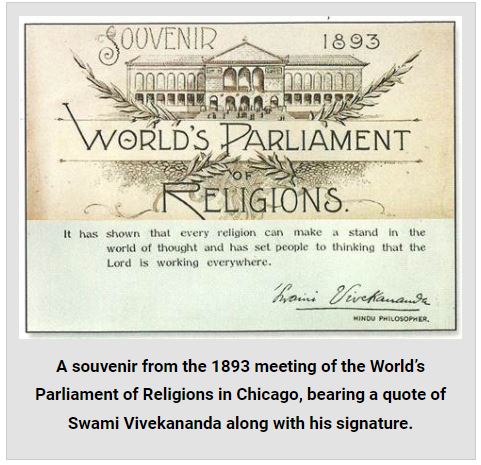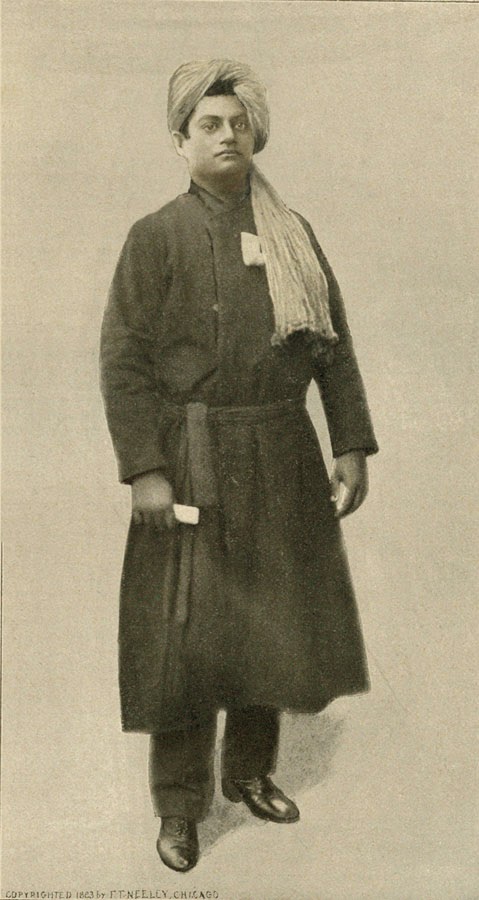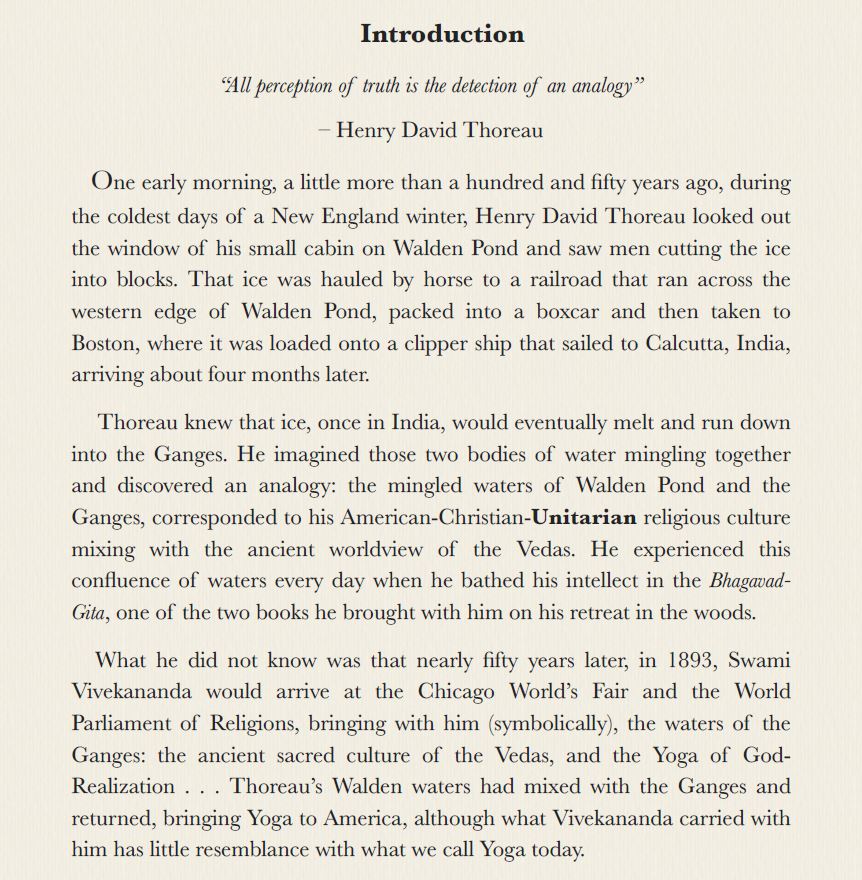Reflections on Water:
How Thoreau’s Walden Pond Mixed with the Ganges
and
Yoga Came to America with Swami Vivekananda
Peter Malakoff

Acknowledgements
No man is an island. No individual exists all by himself and no book was ever written without support and help. This is the place where words are devoted to this understanding; people are remembered, acts are cherished and all the help we were given is acknowledged, our gratitude hung like small prayer flags on a mountain of appreciation.
To Christine, who has been my support and helper, it is a joy to live in your company. Thank you to my dear friends, Mitch and Cathy, who helped me live in America and venture forth to India, making a home for my heart. My deep appreciation goes out to Matteo, who holds down the fort, making ghee for Ancient Organics. I have always been engaged in writing, but it was Ed and Liisa who first encouraged me to publish; thank you for guiding me towards my dharma. Upahar and Chris my cybernii, thank you for your help with editing and correcting my plentiful errors. Buckminster Fuller once said that “a drunk makes less mistakes than a sober man” and I was very sober when I wrote this story. My old friend David Hanks gave me my first living picture of a Yogi and my first copy of the Bhagavad-Gita. Certainly, we knew each other in another lifetime. My parents, Norman and Marjorie, gave me all the love I could wish for and formed the way I see the world. I cannot help but love you and all that you loved. My brother Michael and his wife Louise have been a source of much-needed help for decades. Without you, the road would have been much more difficult. Thank you so very much. Maharishi Mahesh Yogi encouraged me to go to school in Vedic Studies and his interpretation of the first six chapters of the Gita changed my life by putting the horse of God-Realization in front of the cart of renunciation, instead of the other way around. You were a voice of wisdom to me and I am grateful. My Teacher Adi Da Samraj gave me the Teaching, the map, the legend, a picture of what I am looking for, and the Understanding why. Finally, I am grateful to all who have gone before and have gifted me a world of ideas, tools, and their loving hearts.
Introduction
“All perception of truth is the detection of an analogy”
– Henry David Thoreau
One early morning, a little more than a hundred and fifty years ago, during the coldest days of a New England winter, Henry David Thoreau looked out the window of his small cabin on Walden Pond and saw men cutting the ice into blocks. That ice was hauled by horse to a railroad that ran across the western edge of Walden Pond, packed into a boxcar and then taken to Boston, where it was loaded onto a clipper ship that sailed to Calcutta, India, arriving about four months later.
Thoreau knew that ice, once in India, would eventually melt and run down into the Ganges. He imagined those two bodies of water mingling together and discovered an analogy: the mingled waters of Walden Pond and the Ganges, corresponded to his American-Christian-Unitarian religious culture mixing with the ancient worldview of the Vedas. He experienced this confluence of waters every day when he bathed his intellect in the Bhagavad Gita, one of the two books he brought with him on his retreat in the woods.
What he did not know was that nearly fifty years later, in 1893, Swami Vivekananda would arrive at the Chicago World’s Fair and the World Parliament of Religions, bringing with him (symbolically), the waters of the Ganges: the ancient sacred culture of the Vedas, and the Yoga of GodRealization . . . Thoreau’s Walden waters had mixed with the Ganges and returned, bringing Yoga to America, although what Vivekananda carried with him has little resemblance with what we call Yoga today.
After receiving an extraordinarily positive reception at the World Parliament of Religions, Vivekananda went on to travel all over America like a Johnny Appleseed of the Vedas, giving talks and lectures in many cities, sowing the seeds of the ancient philosophy of Vedanta in one of the youngest countries in the world. For nearly every American who heard him, and there were thousands, it was their first exposure to the culture, philosophy and worldview of ancient India.
We find in a seed clear signs of what tree will grow or what fruit is expected. But that takes into account only the seed; the soil, the season and the moisture in which that seed falls must also be taken into consideration. So, what was transpiring in America? What forces were moving in India? What great persons were alive and how did they influence the different aspects of this story? The ground in both America and India had been prepared far ahead of Vivekananda and some of that tale is told here.
In America, the first English translation of the Bhagavad-Gita was read by Thoreau and Emerson and this and other texts from the Vedic literatures of India influenced the small circle of Transcendentalists in the Boston area and through them begin to change the thinking of America.

Emerson and other Unitarians had carried on a correspondence for many years with the leaders of the Brahmo Samaj in India, and in 1883 Pratap Chandra Mazumdar, a leader of the Brahmo Samaj, was the first Indian religious teacher to come to our country and the first place he visited was the home of Ralph Waldo Emerson in Concord, Massachusetts, where he spoke from Emerson’s front porch to local Unitarians at the invitation of Emerson’s wife, Lydia. (Emerson had died one year earlier.)
Ten years later the Chicago World’s Fair celebrated the 400th anniversary of the discovery of the Americas by Columbus. The fair, called the “Columbian Exposition,” recognized “the transfer of the torch of civilization to the new world.” But mostly it is remembered for the grand public display of a phenomenon that would change the whole world: the generation of electricity and the widespread use of electrically operated machines.

The Parliament of Religions was only a small part of the World’s Fair but it represented a tremendous milestone; for the first time in history, representatives of nearly every major religion in the world appeared in the same room together and on the same stage. It was here that Swami
Vivekananda gave his famous talks that brought Vedanta and the Yoga of God-Realization to the attention of the western world.
Like America, India too had ripened with change. Throughout the nineteenth century the English established a western-style educational system, exposing the ancient, tradition-bound mind of the Indian people to the scientific, rational, critical and iconoclastic thinking of the West.
Technological achievements such as trains, bridges, roads, and communication systems were built throughout the sub-continent, demonstrating a different relationship to the world: life need not just be suffered, but could be vastly improved through scientific thinking, technology and machines. The age-old system of Indian caste, culture and belief was challenged through the work of Christian missionaries and the evangelicals who followed them, questioning the bedrock of the ancient tradition of the Vedas; it was to be many years before the west returned the favor.

In the midst of these social and cultural upheavals, one of the greatest Godmen of India, Sri Ramakrishna, attained the highest Realization of the different sects of Hinduism, Christianity and Islam, dramatically resolving the dilemma of religious diversity in his own person. He declared that all religious paths lead to the same God; and it was his disciple, Swami Vivekananda, who carried the Universal values of the Vedic tradition to the West in a form he called “Practical Vedanta” . . . the essence of Vedanta, no longer exclusively tied to the religious traditions of India or the Hindu cultural values in which it had evolved; a message perfectly suited to the quickly growing cross-cultural, multi-religious world of the 20th century.
These are but a few of the many rivers that pour into this story and this tale is not the only one that could be told. Certainly, I have not fully accounted for how Yoga came to America, but I hope I have enriched the questions that could be asked and deepened the mystery.
This book is based on events that really did happen and I have tried to use as often as I could, original reports, photographs and firsthand accounts. Even so, there are many ways to tell this story and widely different understandings of important ideas, scriptures, philosophies, people and events. I am very much aware what I have written is one such interpretation, representing a particular world-view of the subject. How could it not be so?
So, let me tell you a story of the mingling waters of New England and India and how Swami Vivekananda brought Yoga to America.





